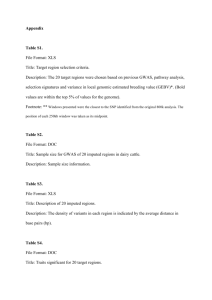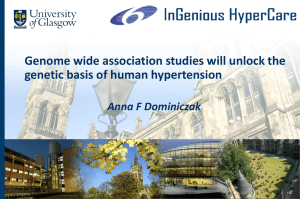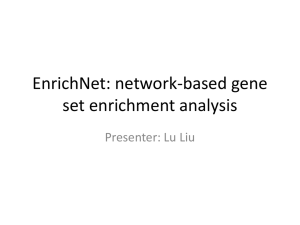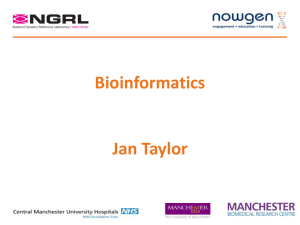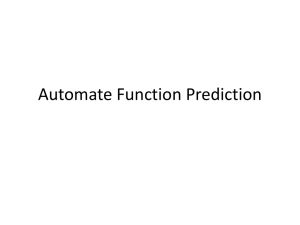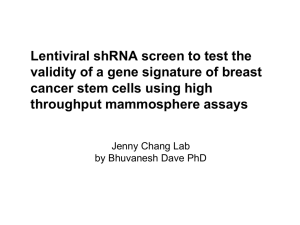Slides
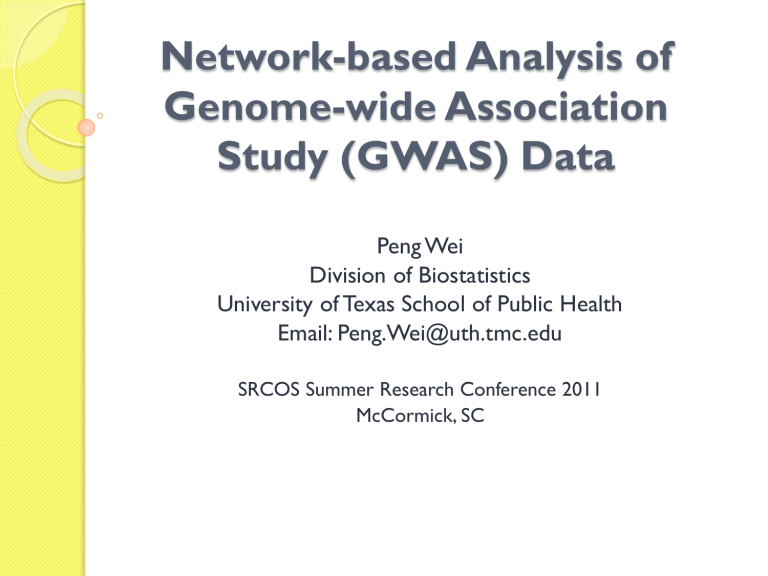
Network-based Analysis of
Genome-wide Association
Study (GWAS) Data
Peng Wei
Division of Biostatistics
University of Texas School of Public Health
Email: Peng.Wei@uth.tmc.edu
SRCOS Summer Research Conference 2011
McCormick, SC
Outline
Background and Introduction
GWAS
Biological networks
Statistical Methods
Gene-based association test
Markov random field-based mixture model
Diffusion kernel-based mixture model
Numerical Results
Conclusion and Discussion
Background: GWAS
Manolio TA. N Engl J Med 2010; 363: 166-176.
Background: GWAS
SNP-by-SNP Analysis
Top hits may not have functional implications
Millions of dependent tests due to linkage disequilibrium (LD) among SNPs – low power
GWAS pathway enrichment analysis:
Uses prior biological knowledge on gene functions and is aimed at combining SNPs with moderate signals
e.g., to test if SNPs in the cell proliferation pathway show difference between cases and controls
However, genes within a pathway are treated exchangeably – interactions among genes ignored
Not every gene in a significant pathway is associated with the disease – identifying disease-predisposing genes remains a challenge
Background: Biological Networks
Metabolic space
Metabolite 1 Metabolite 2
Protein 2
Protein space
Complex 3-4
Protein 4
Protein 1 Protein 3
Gene 2
Gene 1
Gene space
Gene 3
Gene 4 Adapted from Brazhnik P et
al. Trends Biotechnol. (2002)
Background: Gene Networks
HPRD (Human Protein Reference Database; Protein-
Protein Interactions)
-- yeast two-hybrid experiments + hand-curated, literature-based interactions
-8776 genes, 35820 interactions
KEGG (Kyoto Encyclopedia of Genes and Genomes)
-- Extracted from KEGG gene-regulatory pathway database
-1668 genes, 8011 interactions
KEGG network
(1668 genes;
8011 interactions)
Introduction: Network-based methods
Markov random field (MRF)-based mixture models have been proposed for incorporating gene networks into statistical analysis of genomic and genetic data: neighboring genes on a network tend to be co-associated with the outcome
Gene expression data:
Wei and Li, Bioinformatics 2007;
Wei and Pan, Bioinformatics 2008, JRSS-C 2010
)
GWAS data:
Chen et al, PLoS Genetics 2011
Methods: Network-based GWAS
Analysis
SNP data
Gene-level summary
Questions to be addressed here:
1. Does the choice of network matter?
2. Does looking beyond direct neighbors help?
Data: Crohn’s Disease (CD)
A type of inflammatory bowel disease
An auto-immune disease
High heritability– strong genetic link
Large number of confirmed loci
(SNPs/genes)
--105 genes at 71 loci based on metaanalysis of six GWAS ( Franke et al. Nature
Genetics 2010 )
Crohn’s Disease GWAS Data
Wellcome Trust Case Control
Consortium (WTCCC)
2,000 CD cases, 3,000 controls and a total of 500,568 SNPs
Data Quality Control
1748 CD cases and 2938 controls and
469,612 SNPs
Methods: From SNP Level to Gene
Level
SNP to gene mapping– the “20Kb
Rule”
20Kb 20Kb
5’-UTR Gene 3’-UTR
Gene-level summary statistics
Principle component analysis (PCA) followed by logistic regression
SNPs eigen SNPs logit Pr(D
H
0
: β
1 j
=1) = β
= β
2
0
= … =
+ β
1
β p x
1j
= 0
+ … + β p x pj
Methods: From SNP Level to Gene
Level
Gene-level summary statistics
Alternative approach: Logistic Kernelmachine-based test (
Wu et al AJHG 2010
)
z i logit Pr(D j
H
0
=1) =
: h(z)=0
β
0
+ h(z
1j
,…,z pj
) z-score transformation of gene-level pvalues:
= Φ -1 (1- P i
), where Φ is the cdf of N(0, 1)
Methods: Standard Mixture Model
(SMM):
Treats all genes equally a priori
f
0 0
f z
1 1
π
0
= Pr( T i
=0) 1π
0
= π
1
= Pr( T i
=1) f
0
~ ϕ
(
µ
0
,
σ
0
2 ) f
1
~ ϕ
(
µ
1
,
σ
1
2 )
T i
: latent state of gene i
Bayesian framework: p ( T , θ| z )
p ( z | T , θ) p ( T ) p (θ)
θ=(µ
0
, µ
1
, σ
0
2 , σ
1
2 )
Statistical Inference: : p ( T i
=1| z )
Methods:
MRF-based mixture model
(MRF-MM)
The latent state vector 𝑇 = (𝑇
1
, … , 𝑇
𝐺
)′ is modeled as a MRF via the following auto-logistic model logit (P(𝑇 𝑖
|𝑇
(−𝑖)
)) = logit P(𝑇 𝑖
|𝑇
𝜕𝑖
)
= γ + 𝛽 𝑗∈𝜕𝑖
𝐼 𝑇 𝑗
= 1 − where γ is a real number, 𝛽 >0.
𝑗∈𝜕𝑖
𝐼 𝑇 𝑗
= 0 /𝑚 𝑖
,
Bayesian framework: p ( T , θ,Φ| z )
p ( z | T , θ) p ( T |Φ) p (θ) p (Φ)
θ= (µ
0
, µ
1
, σ
0
2 , σ
1
2 ), Φ= (β, γ)
Statistical Inference: : p ( T i
=1| z )
Comparison of gene-based tests (1435 genes on the
KEGG network; red dots are 21 confirmed CD genes)
SMM (Kernel-machine test z-scores)
CD Pathway
Wang K et al., Nat Rev
Genet. 2010
Diffusion Kernel (DFK)
Diffusion Kernel (Kondor and Lafferty
2002): Similarity distance between any two nodes in the network.
𝐾 = exp 𝜏𝐿 = ∞ 𝑚=0
1 if gene i ~ j 𝜏 𝑚 𝑚!
𝐿 𝑚 ,
L ij
= -d i if i = j
0 otherwise
τ >0 : decay factor
L: graph Laplacian d i
: # of direct neighbors of gene i exp(L): matrix exponential of L
Diffusion Kernel (DFK) – beyond direct neighbors
STAT4 -
STAT4
IL18 0.05
IL18R1 0.05
IL18RAP 0.05
TBX21 0.16
IFNG 0.05
IL18
0
-
0.05
0.05
0.16
0.05
-
0
IL18R1 IL18RAP TBX21 IFNG
0 0 1 0
0.24
-
0
1
1
1
1
0
0
0
0.16
0.05
0.16
0.05
-
0.16
-
1
Diffusion Kernel-based mixture model (DFK-MM)
MRF: First-order (direct) interactions
DFK: Interactions of all orders logit Pr
T i
1| T
i
[
j
i
( T j
j
i
( T j
0)] / m i logit Pr
T i
1| T
(
i )
[
K ij
( T j
K ij
( T j
0)]
Conclusion and Discussion
Does the choice of network matter?
Yes, the KEGG gene regulatory seemed to be more informative than the HPRD protein-protein-interaction network
Does looking beyond direct neighbors help?
Yes, the DFK-based model was found to be more powerful than the MRF-based model based on application to the CD GWAS data as well as simulated data (results not shown)
In summary, network-based models were demonstrated to be useful for gene-based GWAS analysis
Network information mainly boosted the power for discovering genes with moderate association signals
Potential problems and future work
Existing gene networks are incomplete
– we use network information as informative prior
Types of networks matter: protein-protein interaction, gene regulatory, co-expression networks, etc – incorporate multiple networks simultaneously
Joint effect vs Marginal effect - regression framework
Acknowledgement
Joint work with Ying Wang (graduate student @ UT School of Public Health)
Support from UT SPH PRIME award
